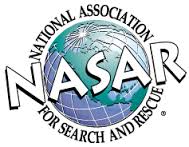
Northstar SAR Team requires each handler to be a SAR Technician II, and just last weekend a group of five of us K9 handlers completed the SAR Tech II field exams and we all passed! This was the second and final component of the national credentialing process through NASAR (National Association of Search and Rescue). Similar to the requirements of the EMS system of psychomotor skills exam and written exam, NASAR requires a written exam (which we all passed in January) and practical skills exam for field work preparedness.
The exam involved four specific skills: (1) navigation using a compass in varied terrain plus using a map with the compass; (2) area and route search for evidence; (3) rope tying of several knots; and (4) man tracking skills. This was much easier than the EMT Psychomotor Skills Exam, except that my compass was off just enough to mess with my sightings, and I finally had to borrow another compass when we realized it was my compass – not me!
The premise of NASAR’s requirements is that personal safety comes first, and searchers should be prepared for the worst case scenario. In other words, it would be ridiculous to send someone on a search for a missing person unless the searcher is competent in the environments in which s/he searches, and thus is not at risk for becoming another lost victim. Unfortunately, there are many people out there who claim to be search-and-rescue units but have little to no training.
So let’s take a scenario to see how those skills could be used. You are in the field with your K9 and another teammate (we always go out in pairs, another safety feature of Northstar) tracking a missing person in the woods. The dog is searching for the scent, and you look at the ground around the area. Some grass is bent over in a shoe shape and in the mud you see a partial print of the type of shoe the missed person was wearing. You are able to track a few steps and identify the direction of travel, and you see a cigarette butt and empty water bottle near those prints which is enough for the dog to catch the scent and keep going. When you get to the victim, she has fallen down a bit of a steep hill. To keep safe, you tie your long rope around a tree and use another rope to create a handle that slides along the long rope to prevent you from falling down the hill. You can even quickly make a harness around yourself to attach to that rope. Your partner is mapping the location using GPS (if it is working in that area!) or a compass and map. When you reach the person, you quickly assess her condition, begin treatment. and radio for backup to initiate transport.
Northstar SAR is a licensed Medical Response Unit in Minnesota, so we are able to deal with many emergencies in the field and treat victims. Each of us carries first aid items including meds (aspirin, antacid, Tylenol) and gear that can treat typical injuries. We have many other items in our ‘ready-packs’ which hold everything you may need for the search, and can weigh up to 70+ pounds. The heaviest item is the water for you and your dog. Keep in mind that my partner, my dog, may get injured so I need to carry supplies for her as well as be trained in canine first aid.
Northstar SAR is a non-profit, volunteer organization deploying only when law enforcement calls us in to find missing people. We welcome donations or any help people can give to enable us to continue to provide services in finding those who are lost.


